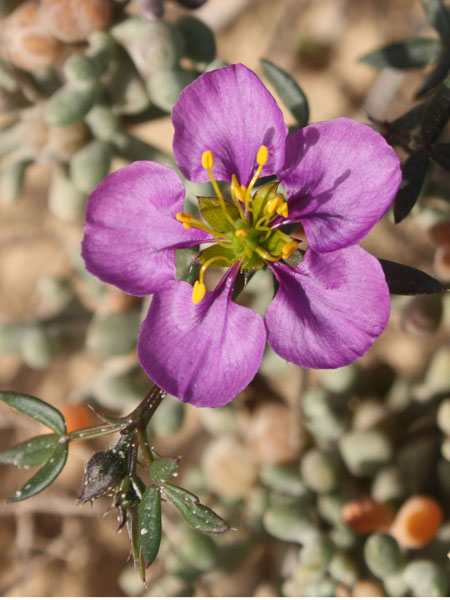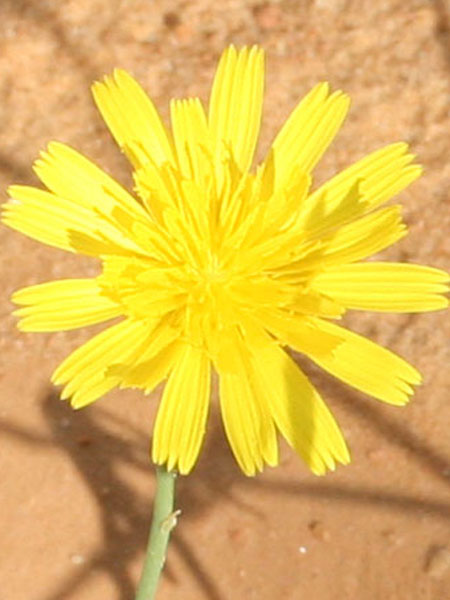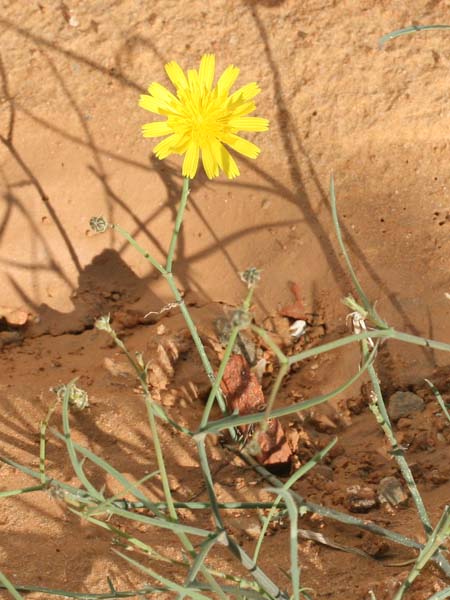Solanum elaeagnifolium
Kingdom : Plantae / النّباتات
Division : Spermaphyta / البذريات
Clade : Magnoliophyta or Angiospermae / مستورات البذور
Class : Eudicotyledoneae / ذات الفلقتين
Order : Solanales / رتبة الباذنجانيات
Family : Solanaceae /الفصيلة الباذِنْجانِيَّات
Genus : Solanum
species : elaeagnifolium
Chromosomes: 2n=24
Protologue
Cav., Icon. Descr. 3: 22, t. 243 (1795)
Synonyms
Solanaum dealbatum Lindley Solanum flavidum Torrey Solanum hindsianum Bentham Solanum leprosum Ortega Solanum roemerianum Scheele Solanum saponaceum Hooker fil in Curtis Solanum texense Engelman & A. Gray Solanum uniflorum Meyer ex Nees
Common names
Tunisia Arabic English French Tamazight
الباذنجان البرّي
الباذنجان الفضي
Silverleaf nightshade
Silver-leaved nightshade
Prairie berry
Silverleaf nettle
White horsenettle
Silver nightshade
Morelle à feuilles de chalef
Toxic
yes
Edible
no
Latex
no
Botanic description
Genus description
"Calyx little or not accrescent, with 5 spreading lobes. Corolla rotaceae, short tube and limb spread to 5 deep lobes, Etamines 5, anther projecting close together in a kind of cone, opening at the top by a kind of pore. Fruit globular or ovoid, berry with 2 multi-woven boxes. Inflorescence in terminal or lateral umbelliform cymes, whole leaves, sinuate or lobed.
Species description
"Perennial herb that can be up to 1 m tall, which can be a little woody at the base. It grows in tuft. Its roots, which are very well developed, can also extend to shallow depths and sink up to 2 m deep. They have a strong propensity to suckle.This plant presents a great morphological variability, particularly the United States, where some confusion taxonomic level.
Stems often pubescent and equipped with thorns whose color varies from yellow to black.
Botanic References
http://www.fcbn.fr/sites/fcbn.fr/files/ressource_telechargeable/fiche
_solanum_elaeagnifolium_sr.pdfwww.theplantlist.org
Biology
Life form Annual Type form Therophyte Photosynthesis C3
Phenology
Blooming
JanuaryFebruaryMarchAprilMayJuneJulyAugustSeptemberOctoberNovemberDecember
Fruiting
JanuaryFebruaryMarchAprilMayJuneJulyAugustSeptemberOctoberNovemberDecember
Map Localization
Ecology
Adaptation It is native to the North American continent, grows in arid open areas, such as roadside or abandoned plots and also in fields, orchards or clearings. Salt bladder yes Invasive yes
Geographical distribution
Localization Biocimatic stage Annuel pluviometry (mm) GPS Monastir (Déc . 2013; Juillet 2016) Inferior semi-arid 331 35°44'58.76"N / 10°49'35.27"E 35°46'2.41"N / 10°48'56.89"E Sousse (Hamam Sousse, Août 2016) Inferior semi-arid 331 35°57'58.64"N / 10°32'1.44"E
General uses
Effective against molluscs and nematodes. It is used to curdle the milk to obtain a kind of cheese and to tan the skins.
Medicinal uses
"It is used in various preparations to treat sore throats and teeth by chewing the root or berries of the plant and to treat problems affecting the respiratory tract, especially in the nose and throat. It has anti-bacterial activity against Staphylococcus aureus and Escherichia coli.
NOTE : This website is not that of herbal medicine and assumes no responsibility for the negative effects of the use of plants. Seek advice from a professional before using a medicinal plant.
Systems / Organs / Effects
Reproductive System Respiratory System Mouth / Teeth Antiseptic Astringent
Test results
TPC DPPH ABTS+ FRAP Year mg GAE g-1 MS CI50 g ml-1 CI50 g ml-1 CE50 g ml-1 11,76± 1,15 19,68± 0,75 36,69± 0,69 189,84± 11,32 2016 Total Phenols content(TPC), Anti-radical potentialities against (DPPH, ABTS), Ferric reducing antioxidant power(FRAP)
Molecules : ADN / Proteins
Chromosomes : 24 Uniprot NCBI
Tunisian references
Other references
Boyd JW.and Murray DS. (1982). Growth and developpement of Silverleaf nightshade (Solanum elaeagnifolium). Weed science 30, 238-243. Brunel S.(2003). Solanum elaeagnifolium (Cav.). Plantes envahissantes de la région méditerranéenne, Agence méditerranéenne de l’environnement, Agence Régionale Pour l’Environnement ProvenceAlpesCôte d’Azur. Brunel S. (2005). Study on invasive plants in the Mediterranean Basin. W.C. Union, IUCN: 54 p. Chevrat C.(2005). Action d’éradication de la Morelle jaune (Solanum elaeagnifolium cav.) sur la commune de Châteauneuflesmartigues, le 5 août2005. Montpellier, Conservatoire Botanique National Méditerranéen de Porquerolles: 6 p. Goeden RD. (1971). Insect ecology of silverleaf nightshade. Weed Science19, 45–51. Mekki M.(2005). Potential threat of Solanum elaeagnifolium Cav. to theTunisian fields. Proceedings of the International Workshop : Invasive Plants in Mediterranean Type Regions of the World, Mèze, Council of Europe publishing. Molnar VM and McKenzie DN (1976) Progress Report on Silverleaf Nightshade Research. Pamphlet no. 61. Keith Turnbull Research Institute, Victoria (AU). Rutherford PA. (1978). Effect of time of immersion in running and still water on the germination of silverleaf nightshade (Solanum elaeagnifolium). Proceedings of the first conference of the Council of Australian Weed Science Societies, pp. 372–378. Synthèse des travaux effectués au Maroc. Rabat,Ministère de l'Agriculture et de la Mise en valeur Agricole Royaume du Maroc: 130 p.
Taleb A and Bouhache M.(2005). Etat actuel de nos connaissances sur les plantes envahissantes au Maroc. Proceedings of the International Workshop : Invasive Plants in Mediterranean Type Regions of the World, Mèze, Council of europe publishing.Bouhache, M. and A. Ameur (1994). Projet Morelle Jaune (Solanum elaeagnifolium Cav.)Tscheulin T, Petanidou T et al. (2009). The impact of Solanum elaeagnifolium, an invasive plant in the Mediterranean, on the flower visitation and seed set of the native coflowering species Glaucium flavum. Plant Ecology 205(1): 7785. Wassermann VD, Zimmermann HG & Neser S. (1988). The Weed Silverleaf Bitter Apple (‘Satansbos’) (Solanum elaeagnifolium Cav.) with special reference to its status in South Africa. Technical Communication no. 214. Department of Agriculture and Water Supply, Pretoria (ZA). Zaki N, Eljadd EL, Oihabi A, Tanji A & Hilali S (1995) Effet de la combinaison de la lutte chimique et mécanique sur la Morelle jaune (Solanum elaeagnifolium Cav.) Deuxième congrès de l’AMPP, Rabat (MA).






















